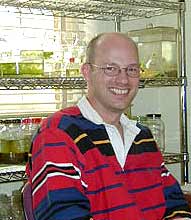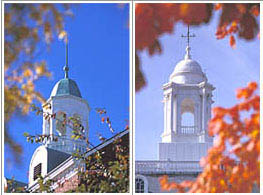|
||||||||||||||||
|

Charles F. DelwicheProfessorPh.D. University of Wisconsin - Madison, 1990Telephone: 301-405-8300 Fax: (301) 314-9082 E-mail: delwiche@umd.edu Research Interests: Plant Molecular Systematics The algae are tremendously important organisms. They are critical to the maintenance of atmospheric oxygen, form the foundation of aquatic food chains, and in the late Ordovician gave rise to the land plant lineage. When eukaryotic diversity is studied with molecular phylogenetic methods, far more sequence divergence is found among algae and other protists than in plants, animals, or fungi. This is consistent with the tremendous cytological and biochemical diversity of protists, as well as with their relatively ancient fossil records, but is frequently not reflected by structural diversity. Some algal taxa (e.g., the green algal genus Chlorella) are junkyards housing phylogenetically disparate taxa, while others -- typically those marked by an unambiguous structural feature -- are natural groups by any measure. But even in well defined algal taxa, considerable sequence divergence is often observed, and the biological significance of this diversity at the molecular level is not well understood. Recent advances in systematics, particularly the use of molecular data analyzed with objective methods, have made it practical to reconstruct the history or evolution with confidence. Information on how organisms are related to each other can be used to infer how the features of those organisms evolved. This comparative biological approach can be used to make generalizations about groups of organisms that are not possible with reductive methods alone. My laboratory uses DNA sequencing, computer analysis, and structural and biochemical studies to understand the phylogeny and evolution of algae, with particular emphasis on two problems; the early evolution of plastids (i.e., chloroplasts), and the green algal origin of land plants. There are two major projects currently underway in the lab. The first is a study of the systematics and diversity of the Charophyta, the group of green algae that gave rise to land plants. This study is funded through the NSF program "Partnerships for Enhancing Expertise in Taxonomy (PEET)," and aims to use state of the art techniques to understand the diversity, fundamental biology, and develop appropriate classifications for this key group of algae. The second project is focused on understanding the relationship between the chloroplast and nuclear genomes in dinoflagellates. Dinoflagellates are an environmentally and economically important group of eukaryotes which include representatives both with and without plastids. Furthermore, among those with plastids it is clear that plastids have been acquired independently several times. By studying this history of plastid acquisition we hope to gain insight into the factors that influence the origin and evolution of plastids. This project has received funding from both the Alfred P. Sloan Foundation and the National Science Foundation. Representative PublicationsDelwiche, C. F., M. Kuhsel, and J. D. Palmer. 1995. Phylogenetic analysis of tufA sequences indicates a cyanobacterial origin of all plastids. Mol. Phylog. Evol. 4:110-128. Delwiche, C.F., and J. D. Palmer. 1996. Rampant horizontal transfer and duplication of rubisco genes in eubacteria and plastids. Mol. Biol. Evol. 13:873- 882. Kohler, S., C.F. Delwiche, L.G. Tilney, P. Webster, R.J.M. Wilson, J.D. Palmer, and D.S. Roos. 1997. A plastid of probable green algal origin in apicomplexan plastids. Science 275:1485-1489. Delwiche, C.F. 1999. Tracing the thread of plastid diversity through the tapestry of life. The American Naturalist 154:S164-S177. Tengs, T., O.J Dahlberg, K. Shalchian-Tabrizi, D. Klaveness, K. Rudi, C.F. Delwiche and K.S. Jakobsen. 2000. Phylogenetic analyses indicate that the 19`hexanoyloxy-fucoxanthin-containing dinoflagellates have tertiary plastids of haptophyte origin. Mol. Bio. Evol 17:718-729. Cimino, M.T., K.G. Karol, and C.F. Delwiche. 2000. An artifact in the SSU rDNA sequence of Chaetosphaeridium globosum (Chlorophyta: Charophyceae). J. Phycol.36:440-442. Oldach, D.W., C.F. Delwiche, K.S. Jakobsen, T. Tengs, E.G. Brown, J.W. Kempton, E.F. Schaefer, H.A. Bowers, H.B. Glasgow Jr., J.M. Burkholder, K.A. Steidinger, and P.A. Rublee. 2000. Heteroduplex mobility assay guided sequence discovery: elucidation of the small subunit (18S) rDNA sequences of Pfiesteria piscicida and related dinoflagellates from complex algal culture and environmental sample DNA pools. Proc. Natl. Acad. Sci USA: 97:4303-4308. Karol, K.G., R.M. McCourt, M.T. Cimino, and C.F. Delwiche. 2001. The closest living relatives of land plants. (submitted). For more information on Dr. Delwiche: | ||||
|
|
|||||
|
